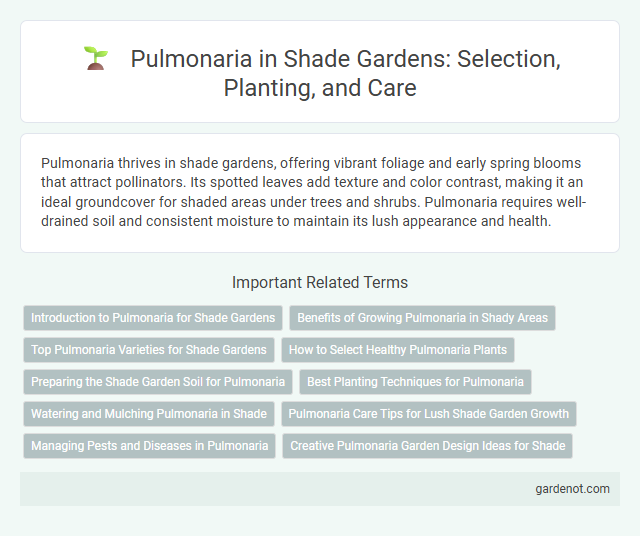Pulmonaria thrives in shade gardens, offering vibrant foliage and early spring blooms that attract pollinators. Its spotted leaves add texture and color contrast, making it an ideal groundcover for shaded areas under trees and shrubs. Pulmonaria requires well-drained soil and consistent moisture to maintain its lush appearance and health.
Introduction to Pulmonaria for Shade Gardens
Pulmonaria, commonly known as lungwort, thrives in shade gardens due to its tolerance for low light and moist soil conditions. Its attractive spotted leaves and early spring blooms in shades of pink, blue, and purple provide vibrant color during the dormant season. Pulmonaria also supports pollinators by offering nectar when few other plants are flowering.
Benefits of Growing Pulmonaria in Shady Areas
Pulmonaria thrives in shady garden areas, offering vibrant early spring blooms that attract pollinators like bees and butterflies. Its spotted, evergreen foliage provides year-round visual interest and helps suppress weeds by creating a dense ground cover. Pulmonaria also improves soil health by tolerating moist, nutrient-rich conditions common in shaded spots, making it a low-maintenance choice for shade gardens.
Top Pulmonaria Varieties for Shade Gardens
Pulmonaria, commonly known as lungwort, thrives in shaded garden areas and offers a variety of top cultivars such as Pulmonaria saccharata 'Mrs. Moon', Pulmonaria officinalis 'Majeste', and Pulmonaria longifolia. These varieties feature striking spotted or variegated leaves alongside vibrant blue, pink, or lavender flowers that brighten leafy, shaded spots. Their early spring blooms and exceptional shade tolerance make them essential perennial plants for enhancing the texture and color diversity in shade gardens.
How to Select Healthy Pulmonaria Plants
Choose Pulmonaria plants with vibrant, mottled leaves free from discoloration or wilting to ensure vitality. Inspect the root system for firm, white roots without signs of rot or dryness to promote successful transplanting. Select specimens with intact, healthy foliage and avoid those showing pest damage or fungal spots for optimal growth in shade gardens.
Preparing the Shade Garden Soil for Pulmonaria
Pulmonaria thrives in rich, well-draining soil with high organic matter content, ideal for shade garden conditions. Incorporate compost or aged leaf mold to improve moisture retention and nutrient availability while maintaining slightly acidic to neutral pH levels (6.0 to 7.0). Ensure the soil is loosened to about 8-12 inches deep to support healthy root development and prevent waterlogging common in dense shade soils.
Best Planting Techniques for Pulmonaria
Pulmonaria thrives in well-drained, fertile soil enriched with organic matter, planted in partial to full shade to mimic its natural woodland habitat. Ensure spacing of 12 to 18 inches between plants to promote air circulation and reduce the risk of fungal diseases common to Pulmonaria. Regular mulching with leaf mold or compost helps maintain consistent soil moisture and protect roots during seasonal temperature fluctuations.
Watering and Mulching Pulmonaria in Shade
Pulmonaria thrives in consistently moist, well-drained soil, requiring regular watering to prevent dryness, especially during hot, dry periods in shaded gardens. Applying a 2-3 inch layer of organic mulch such as leaf mold or shredded bark helps retain soil moisture, suppress weeds, and regulate root temperature in shade conditions. Proper watering combined with mulching reduces stress on Pulmonaria, promoting vibrant foliage and prolonged flowering in shaded or partially shaded areas.
Pulmonaria Care Tips for Lush Shade Garden Growth
Pulmonaria thrives in well-drained, consistently moist soil rich in organic matter, making it ideal for shade gardens. Regular watering is essential, especially during dry spells, to maintain vibrant foliage and prevent stress. Applying mulch helps retain soil moisture and suppress weeds, promoting lush growth and vibrant blooms.
Managing Pests and Diseases in Pulmonaria
Pulmonaria thrives best in well-drained, shaded environments but requires vigilant management of pests like slugs and aphids, which can cause leaf damage and disease spread. Regular inspection and the use of organic slug pellets or insecticidal soap help control infestations without harming beneficial insects. Implementing good garden hygiene, such as removing debris and avoiding overhead watering, reduces the risk of fungal diseases like powdery mildew and leaf spot in Pulmonaria plants.
Creative Pulmonaria Garden Design Ideas for Shade
Pulmonaria thrives in shaded garden areas, offering vibrant variegated foliage and early spring blooms that add texture and color to low-light environments. Incorporating Pulmonaria in shade garden designs provides a natural groundcover beneath trees or alongside ferns, enhancing layered planting schemes with its spotted leaves and bell-shaped flowers. Combining Pulmonaria with hostas and astilbes creates dynamic shade gardens that balance visual interest with moisture-retentive soil, ideal for woodland-inspired landscapes.
Pulmonaria Infographic

 gardenot.com
gardenot.com